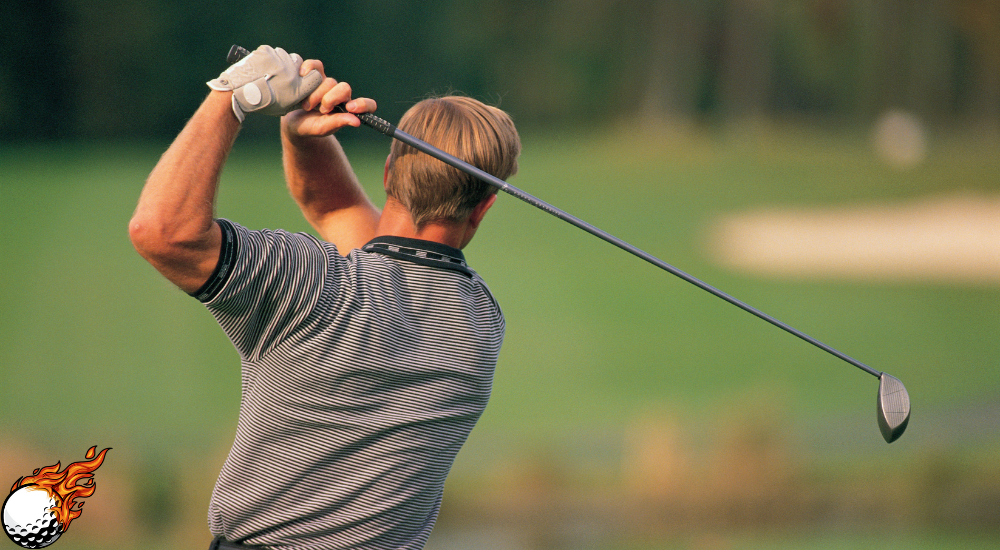
Tired of those weak, sliced drives?
You’re not alone! Most golfers struggle with a steep swing, causing the club to come down too vertically. Pros like Dustin Johnson have a secret weapon: a shallow golf swing.
This technique lowers the club to a flatter angle, resulting in longer, straighter shots. Would you be ready to transform your swing?
This guide is your key to unlocking the power of shallowing the club.
How to Shallow the Golf Club
- What it is: Shallower swings involve bringing the club down on a flatter angle instead of steeply.
- Why it matters: It helps you hit the ball farther, straighter, and more consistently.
- How to do it:
- Practice drills like the “Two-Plane,” “Elbow Plane,” and “Feet Together” drills.
- Focus on proper body rotation and avoid sliding your hips.
- Watch videos of pro golfers and try to mimic their swing plane.
- Be patient and have fun with the process!
- Common mistakes to avoid:
- Starting the downswing with your upper body.
- Casting the club (releasing the angle in your wrists too early).
- Over-rotating your hips.
- Remember: Golf is a journey. Enjoy the process of learning this new skill, and don’t be afraid to seek help from a coach or other resources.
The Basics Shallow Swing
I think we should get down to basics. Understanding the basics of shallow swing

What’s a Shallow Swing?
Now, picture a pro golfer’s swing. Notice how the club seems to sweep the ball away?
That’s a shallow swing. The club comes down at a flatter angle, more like a sidearm throw. This allows the club head to build up more speed and hit the ball with more power.
It also helps you hit the ball straighter because the clubface is coming into the ball more squarely.
The Wall Drill: A Simple Test
I don’t know if you have a steep or shallow swing. Try this simple drill:
- Stand facing a wall, about an arm’s length away.
- Hold your club like you’re about to hit a shot.
- Make a few practice swings.
- See where your trail arm (right arm for right-handed players) is when it’s parallel to the ground.
If your trail arm is above your left arm, that’s a sign of a steep swing. Ideally, you want your trail arm to be level with or even slightly below your left arm.
This means your swing is shallower, which is what we’re aiming for.
Why Shallowing the Club is Crucial
Why Shallowing the Club is Crucial
So, why all the fuss about shallowing the club? Let me break it down for you:
More Distance
Shallowing the club is like giving your swing a turbo boost. When the club comes down on a flatter angle, it increases the clubhead speed.
Think of it like cracking a whip – the longer the whip, the faster the tip moves. It’s the same with your golf swing.
The more shallow your swing plane, the faster your clubhead will be moving when it hits the ball. This translates into longer drives.
Straighter Shots
If you’re sick of those pesky slices, shallowing the club could be your cure. A steep swing tends to make the clubface open at impact, leading to a slice.

But with a shallow swing, the clubface comes into the ball more squarely. This means you’ll hit the ball straighter, and your shots will stay on your target line more often.
Improved Consistency
Shallowing your swing isn’t just about hitting it further and straighter.
It’s also about making your swing more repeatable. A shallow swing is easier to control than a steep one. Think about it: it’s easier to swing a baseball bat horizontally than to swing it vertically.
The same principle applies to your golf swing. When your swing is shallower, you’ll have more control over your body movements, which means your shots will be more consistent.
How Shallower Helps
Here’s a quick recap of how shallowing the club helps your game:
- A shallower swing plane increases clubhead speed, which leads to longer drives.
- A shallow swing helps you hit the ball straighter by squaring the clubface at impact.
- A shallow swing is easier to repeat, leading to more consistent shots.
Let’s be real; most of us aren’t trying to become the next Dustin Johnson. But who wants to avoid hitting the ball farther, straighter, and more consistently?
By letting the club know, you can do just that.
Drills and Techniques for Shallowing the Club
Okay, you’re probably wondering, “How do I actually shallow the club?” Don’t worry, it’s not that hard. Here are some drills and tips even amateur golfers can use:
Two-Plane Drill
This drill helps you visualize the difference between a steep and shallow swing:
- Hold a club in front of you, like you’re pointing at something across the room. This is your first “plane.”
- Now, tilt the club up so it points more towards the ceiling. This is your second “plane.”
- Start your backswing in the steeper, second plane. As you begin your downswing, let the club drop down into the shallower, first plane.
- Imagine you’re swinging under a low-hanging tree branch – that’s the feeling you want to have.
Elbow Plane Drill
This drill helps you get your trail elbow in the right position for a shallow swing:
- Take your normal grip, but place a headcover or small towel under your right armpit (for right-handed golfers).
- Make some swings, keeping the headcover or towel in place.
- This will help you feel what it’s like to have your elbow closer to your body, which is key for a shallow swing.
Feet Together Drill

This drill might feel a little silly, but it works wonders:
- Stand with your feet together, almost touching.
- Make some swings. You’ll naturally start to shallow the club because your stance doesn’t allow for a steep swing.
- Gradually widen your stance, but try to maintain that shallow feeling.
Think Like a Pro:
The pros have a few tricks up their sleeves when it comes to shallow the club. Here are some tips to steal from them:
- Right Shoulder Down: As you start your downswing, focus on dropping your right shoulder (for right-handed golfers). This helps you swing from the inside and prevents an over-the-top move.
- Hand Path Inside: Instead of letting your hands get stuck behind your body, imagine swinging your hands from the inside. This promotes a shallower angle of attack.
- Visualize a Low-Hanging Branch: Like in the two-plane drill, imagine there’s a low-hanging branch you need to swing under. This mental image can help you narrow the club naturally.
Remember, these are just a few of the many drills and techniques you can use to shallow the club. Experiment and see what works best for you.
And don’t get discouraged if it doesn’t happen overnight—mastering this skill takes time and practice.
But the rewards – longer, straighter, more consistent shots – are definitely worth it.
Additional Tips for Success
Okay, you’ve got some drills under your belt; let’s talk about some extra tips and tricks to make shallowing the club even easier:
It’s All Connected
The golf swing involves your whole body, not just your arms.
To shallow the club, you need to get your lower body working with your upper body. A smooth transition between your backswing and downswing is key.
Think of it like a chain reaction: your lower body starts the downswing, then your hips rotate, and finally, your arms come through. This sequence helps you narrow the club naturally.
Rotate, Don’t Slide
One of the biggest mistakes many golfers make is sliding their hips toward the target line instead of rotating them. This makes it almost impossible to narrow the club.

Think about turning your belt buckle towards the target, not your belly button. This will help you get into the horizontal position to swing the club on a shallower swing plane.
Watch the Tour Pros
Watch videos of the best players in the world.
Please pay attention to how they rotate their bodies and how their arms move during the swing. You can learn a lot by simply observing how the pros do it.
You can even try to mimic their movements in slow motion to get a feel for the right sequence.
Get Creative
You don’t need a fancy golf course or expensive lessons to practice shallowing the club. You can do it in your backyard, in your living room, or even at the park. Just grab a club and start swinging!
You can even use a mirror or video to check your form and see if you’re shallowing the club correctly.
Have Fun with It
Golf is supposed to be fun! I would encourage you to stay focused on technique. Just relax, have fun, and enjoy the process of learning a new skill.
To remind you, shallowing the club is a journey, not a destination. It takes time and practice to get it right, but the more you practice, the better you’ll get and the more fun you’ll have on the course.
And remember, there are tons of resources available to help you on your journey. You can find instructional videos online, read articles and blogs, or even take lessons from a PGA professional.
The most important thing is to keep practicing and never give up. With a little bit of effort and perseverance, you’ll be shallowing the club like a pro in no time.
Common Mistakes to Avoid
Okay, you’ve got the knowledge and the drills – now let’s talk about some common mistakes that can mess up your quest for the perfect shallow swing.
- Starting with the Upper Body:
- Think of your swing like cracking a whip – the handle (your lower body) goes first.
- If your upper body starts the downswing, you’ll create a steep swing.
- Let your lower body lead to shallow the club naturally.
- Casting the Club:
- Casting is when you release the angle in your wrists too early, like throwing a ball with a limp wrist.
- Keep the angle in your wrists until the last moment for more power and a shallower club.
- This creates lag, which is like a slingshot effect, adding speed to your swing.
- Over-Rotating the Hips:
- Hip rotation is important, but too much can cause an out-to-in swing path, leading to pulls and hooks.
- Focus on rotating your hips just enough to clear a path for the club, not overdoing it.
Here are some extra tips to help you master the shallow swing:
- Video Yourself: Record your swing and compare it to videos of tour pros. This helps you see what you need to improve.
- Get Feedback: Ask a friend or coach for their feedback on your swing. Sometimes, an outside perspective can be really helpful.
- Be Patient: Shallower swings take time and practice. Stick with it, and you’ll see results. Remember, golf is about having fun, so enjoy the process of improving your game!
Conclusion

Shallowing the club might feel a little weird at first, but trust me, it’s worth it.
It’s like learning a new dance move – it takes practice, but once you get it, you’ll be showing off your smooth moves on the course.
Remember, it’s not about how hard you can swing or how fast you can rotate. It’s about swinging the club on the right path. And with a shallow swing, that path is flatter, more efficient, and a whole lot more powerful.
Feel free to experiment and find what works best for you.
Not every golfer is Rory McIlroy, and that’s okay. The important thing is to find a way to shallow the club that feels comfortable and natural for you.
And who knows, you’ll even surprise yourself with how much your game improves. So get out there, practice those drills, and start shallowing your way to better golf!
Frequently Asked Questions
What would you suggest as the easiest way for beginners to narrow down the club?
Focus on the “Two-Plane” and “Feet Together” drills. They help you feel the correct motion without overwhelming you with too many moving parts. Remember, small changes can make a big difference.
Does shallowing the club affect my distance?
Absolutely! A shallower swing increases clubhead speed, which translates to more distance. It’s like a slingshot – the flatter angle builds up more energy for a powerful release.
How long does it take to learn how to bowl the club?
It varies for each golfer. Some players see improvements quickly, while others take more time. Consistent practice is key. Remember, even small adjustments to your swing plane can have a positive impact.
Can I shallow the club with any golf club?
Yes, you can apply the principles of shallowing to all clubs in your bag. However, it’s often easiest to start with shorter irons and gradually work your way up to longer clubs like the driver. Club shallow golf is very interesting.
Is there a specific point in my swing where I should focus on shallowing?
The transition from the backswing to the downswing is the most crucial moment. As you start your downswing, focus on feeling like you’re dropping the club down into a shallower plane rather than swinging it over the top.













